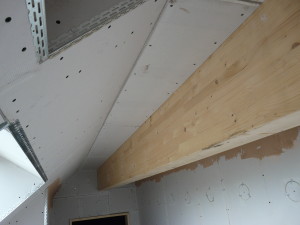The log burning stove was delivered (last week – but I didn’t mention it because it came damaged). The replacement one has now arrived and been installed. There is an interesting bit of kit associated with it, called a Laddomat. This is in part controlled by a flue thermostat. When the log burning stove is lit and the flue gets hot, the stat turns on the pump in the Laddomat. To begin with water is cycled through the stove only, until it gets to 60C. Then a limited amount of cold water from the thermal store is allowed to join, such that the outflow to the thermal store remains hot. This has two benefits. First, that the stove walls come up to temperature quickly, and stay warm, which reduces condensation on them and thus corrosion, so prolonging the life of the stove. Secondly, the water entering the thermal store is at a high temperature, so that water at a useful temperature begins to be stored. If this is not done, the stove would attempt to heat all the water in the thermal store at once. It could therefore be several hours before there was any water at a useful temperature. (The thermal store has a page to itself – see under Definitions &c at the tope of the page.)
The shape and size of the house has been, partly, revealed again as most of the scaffolding round the outside has been taken down. On the south side, in particular, there’s more light in the house and the house, from the outside, looks smaller. Some of it has been put up again inside, so that it’s easier to put up the plasterboard into the top of the internal ridge.
Details. It’s very difficult to plaster into an acute angle, such at the top of the building where the sloping ceiling meets the ridge beam. So when the insulation has been put in, battens to support plasterboard need to be fitted so that the ceiling is squared off for few inches and can meet the beam at a right angle.

